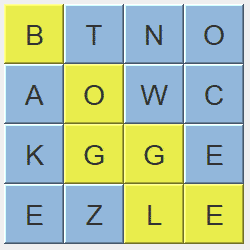
Princeton Algorithm Assignment Boggle
普林斯顿大学算法课 Boggle
实现一个 Boggle 游戏,由自己决定采用什么数据结构和搜索方法。
基本就是字典树(Trie)的实际应用。
提供了 BogleBoard 类和 BoggleGame 类,可以很方便把自己写的 Solver 给整合进去,直接编译成可以玩的游戏,顺便也验证一下结果是否正确。
Trie 的正确实现不难,DFS 也很无脑,基本可以轻松拿到 80 到 90 分,主要是性能上的优化,想要拿满分(甚至 bonus),需要考虑:
- 回溯优化:当某一个结点的没有孩子的时候,不需要进行 DFS;
if (node.hasChild()) {
for (int x = -1; x <= 1; x++) {
for (int y = -1; y <= 1; y++) {
int newRow = row + x;
int newCol = col + y;
if (isValid(board, newRow, newCol) && !visited[newRow][newCol]) {
dfs(board, newRow, newCol, visited, node);
}
}
}
}
- 单词只包含 A 到 Z,所以直接使用 26 个结点的 Trie,比 TNT 快很多(虽然占用了更多的内存);
// Recall that the alphabet consists of only the 26 letters A through Z // Use trie 26, more space but faster than TNT links = new TrieNode[26];
- DFS 中的前缀查询,通常会得到一致的结果, 只是每次长了一个字符,所以不需要每一次都进行前缀查询,保存 TrieNode 的状态,在每一次 DFS 中更新;
public TrieNode prefixNode(char c, TrieNode cache) {
if (cache == null) {
cache = root;
}
if (cache.contains(c)) {
cache = cache.get(c);
} else {
return null;
}
return cache;
}
- 由于 Q 之后只会包含 u,不存在 Qx 的情况,所以没必要在 Trie 中存储 Qu,只需要 Q 就可以了,处理时特判 Q,跳过 u;
if (c == 'Q') {
i++; // Skip "Qu"
if (i == word.length() || word.charAt(i) != 'U') {
// Ignore "Q" and "Qx"
return false;
}
}
i++;
- 不要使用 Set,在 TrieNode 中增加一个标记,表示这个单词是否被添加过,例如当访问过了之后修改这个 TrieNode 的 added 为 true,但是注意,我们会对同一个字典(Trie)执行多次 getAllValidWords,所以仅用 true/false 不足以表示这样的情况,我们在 TrieNode 中增加一个 uid 字段,每次执行 getAllValidWords 时增加 uid,判断在当前 uid 下,这个单词是不是被加入过;
public Iterable<String> getAllValidWords(BoggleBoard board) {
answers = new ArrayList<>();
uid++;
// DFS
return new ArrayList<>(answers);
}
if (node.isEnd() && node.getUid() != uid) {
String word = node.getWord();
if (word.length() > 2) {
answers.add(word);
node.setUid(uid);
}
}
- 不要在 DFS 中用类似 StringBuilder 的东西,在 Trie 中构造字符串,并存在 TrieNode 中,因为 Trie 只会被构建一次,这样之后 DFS 直接根据 Node 中的字符串输出单词,就会快很多。
参考解决方案的每秒查询数大概在 8000 次左右,要求 reference/student ratio 小于等于 2,即实现方案的每秒查询数大于 4000 就可以得到满分,上面这些方案的任意组合足以达到 ratio <= 1,即每秒查询 8000 次以上。
如果还想要获得 Bonus(ratio <= 0.5,即每秒查询 16000 次以上),需要额外处理:
Precompute the Boggle graph, i.e., the set of cubes adjacent to each cube. But don’t necessarily use a heavyweight Graph object: To caculate the key for every point, which means key = y * width + x, then for every point, save current key’s neighbors key in int[][] graph , therefore we need a letter array to map the key to the letter in board.
public class Trie {
private final TrieNode root;
public Trie() {
root = new TrieNode();
}
public void insert(String word) {
TrieNode node = root;
int i = 0;
while (i < word.length()) {
char c = word.charAt(i);
if (!node.contains(c)) {
node.put(c);
}
node = node.get(c);
if (c == 'Q') {
i++; // Skip "Qu"
if (i == word.length() || word.charAt(i) != 'U') {
// Ignore "Q" and "Qx"
return;
}
}
i++;
}
node.setEnd(word);
}
public boolean search(String word) {
TrieNode node = root;
int i = 0;
while (i < word.length()) {
char c = word.charAt(i);
if (node.contains(c)) {
node = node.get(c);
} else {
return false;
}
if (c == 'Q') {
i++; // Skip "Qu"
if (i == word.length() || word.charAt(i) != 'U') {
// Ignore "Q" and "Qx"
return false;
}
}
i++;
}
return node.isEnd();
}
public TrieNode prefixNode(char c, TrieNode cache) {
if (cache == null) {
cache = root;
}
if (cache.contains(c)) {
cache = cache.get(c);
} else {
return null;
}
return cache;
}
}
public class TrieNode {
private final TrieNode[] links;
private boolean hasChild;
// Unique ID here indicates the different getAllValidWords() call, to see if it should be added
private int uid;
// Build string here, because the trie will be built only once
// Do not build strings in the DFS
private String word;
public TrieNode() {
// Recall that the alphabet consists of only the 26 letters A through Z
// Use trie 26, more space but faster than TNT
links = new TrieNode[26];
hasChild = false;
uid = 0;
word = null;
}
public boolean isEnd() {
return word != null;
}
public void setEnd(String w) {
this.word = w;
}
public TrieNode get(char c) {
return links[c - 'A'];
}
public void put(char c) {
links[c - 'A'] = new TrieNode();
hasChild = true;
}
public boolean contains(char c) {
return links[c - 'A'] != null;
}
public boolean hasChild() {
return hasChild;
}
public void setUid(int uid) {
this.uid = uid;
}
public int getUid() {
return uid;
}
public String getWord() {
return word;
}
}
import edu.princeton.cs.algs4.In;
import edu.princeton.cs.algs4.StdOut;
import java.util.Arrays;
import java.util.ArrayList;
public class BoggleSolver {
private final Trie trie = new Trie();
private ArrayList<String> answers = null;
private int uid = 0;
// Initializes the data structure using the given array of strings as the dictionary.
// (You can assume each word in the dictionary contains only the uppercase letters A through Z.)
public BoggleSolver(String[] dictionary) {
if (dictionary == null) {
throw new IllegalArgumentException();
}
for (String word : dictionary) {
trie.insert(word);
}
}
// Returns the set of all valid words in the given Boggle board, as an Iterable.
public Iterable<String> getAllValidWords(BoggleBoard board) {
if (board == null) {
throw new IllegalArgumentException();
}
answers = new ArrayList<>();
uid++;
boolean[][] visited = new boolean[board.rows()][board.cols()];
for (int row = 0; row < board.rows(); row++) {
for (int col = 0; col < board.cols(); col++) {
clearVisited(visited);
dfs(board, row, col, visited, null);
}
}
return new ArrayList<>(answers);
}
private void clearVisited(boolean[][] visited) {
for (boolean[] b : visited) {
Arrays.fill(b, false);
}
}
private boolean isValid(BoggleBoard board, int row, int col) {
return row >= 0 && row < board.rows() && col >= 0 && col < board.cols();
}
private void dfs(BoggleBoard board, int row, int col, boolean[][] visited, TrieNode cache) {
char c = board.getLetter(row, col);
visited[row][col] = true;
TrieNode node = trie.prefixNode(c, cache);
// Add a sign in TrieNode, to know if this word has already been added
// Instead of using a Set
if (node != null) {
if (node.isEnd() && node.getUid() != uid) {
String word = node.getWord();
if (word.length() > 2) {
answers.add(word);
node.setUid(uid);
}
}
// Make sure that you have implemented the critical backtracking optimization
// Means when next trie node is null, no need to dfs more
if (node.hasChild()) {
for (int x = -1; x <= 1; x++) {
if ((x == -1 && row == 0) || (x == 1 && row == board.rows() - 1)) {
continue;
}
for (int y = -1; y <= 1; y++) {
if ((y == -1 && col == 0) || (y == 1 && col == board.cols())) {
continue;
}
if (x == 0 && y == 0) {
continue;
}
int newRow = row + x;
int newCol = col + y;
if (isValid(board, newRow, newCol) && !visited[newRow][newCol]) {
dfs(board, newRow, newCol, visited, node);
}
}
}
}
}
visited[row][col] = false;
}
// Returns the score of the given word if it is in the dictionary, zero otherwise.
// (You can assume the word contains only the uppercase letters A through Z.)
public int scoreOf(String word) {
if (trie.search(word)) {
int length = word.length();
if (length < 3) {
return 0;
} else if (length <= 4) {
return 1;
} else if (length == 5) {
return 2;
} else if (length == 6) {
return 3;
} else if (length == 7) {
return 5;
} else {
return 11;
}
} else {
return 0;
}
}
public static void main(String[] args) {
In in = new In(args[0]);
String[] dictionary = in.readAllStrings();
BoggleSolver solver = new BoggleSolver(dictionary);
BoggleBoard board = new BoggleBoard(args[1]);
int score = 0;
int count = 0;
for (String word : solver.getAllValidWords(board)) {
StdOut.println(word);
score += solver.scoreOf(word);
count++;
}
StdOut.println("Score = " + score);
StdOut.println("Count = " + count);
}
}
